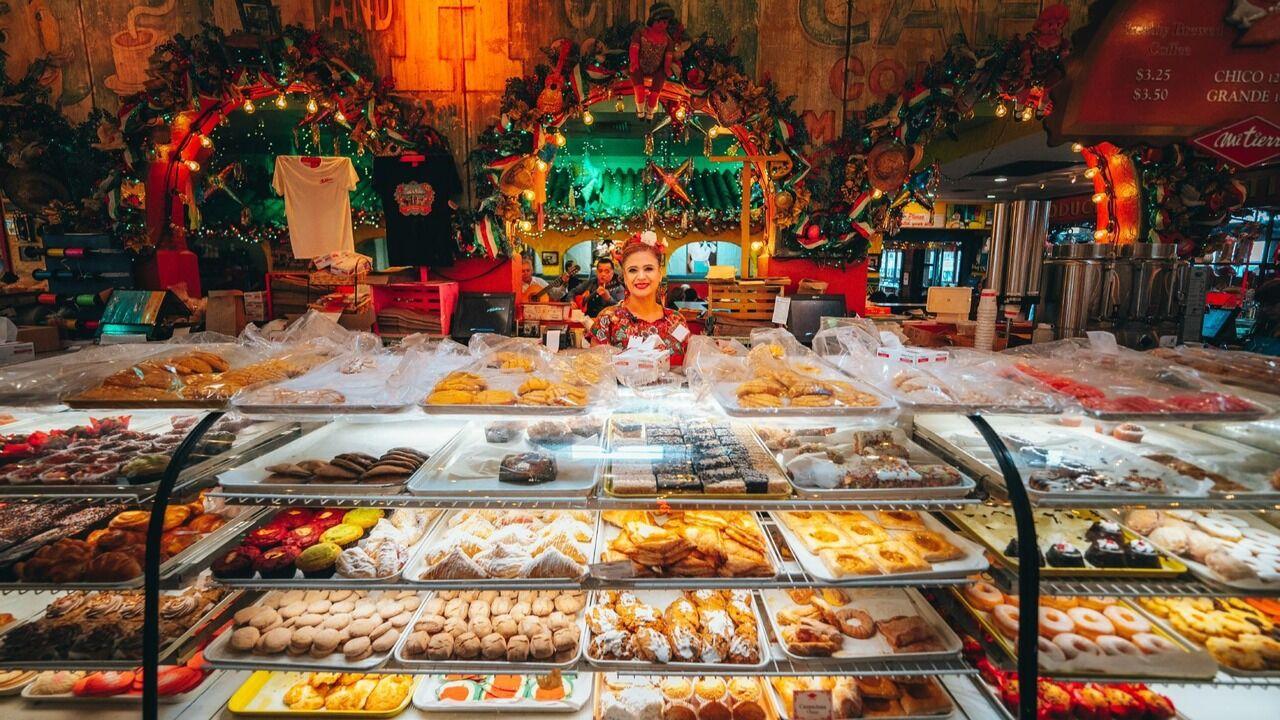The hospitality Industry brought nearly $262 million into the city of San Antonio’s coffers in 2022, according to a study by Trinity University. That’s almost 20% of their budget — and it’s only scratching the surface. The economic impact of the restaurant businesses alone contributed $10 billion to the city’s overall economy.
San Antonio is experiencing an explosion of gastronomic success. The record-setting economic impact is still on the rise as eateries embrace the vibrant and diverse cultural and social atmosphere of Alamo City.
“I remember seeing people moving here, and they’re like, this is going to be the next epicenter of food,” says Chef Nicola Blaque, owner of The Jerk Shack and Freight Chicken.
When you ask about the best food city in America, some pretty standard answers come up. New York, Chicago, L.A., San Francisco, New Orleans. But San Antonio, Texas, demands their place in that discussion. And people are listening — both across America and around the world.
“We love food,” says James Beard-nominated pastry chef Sofia Tejeda. “Who would have thought that I, at 26, would be the first pastry chef in the city to get a James Beard nomination? It was a dream, it was a goal, but I never thought it would be a possibility here.”
Diversity and Growth
One of the strongest indicators that something special is happening in San Antonio is the remarkable economic turnaround and growth the hospitality industry has seen since the COVID-19 pandemic. Since 2020, more than 100 new restaurants have opened, and the total payroll for the hospitality industry has passed 2019 levels, according to the same 2023 study from Trinity University.
The study also showed the recovery speed of San Antonio has surpassed many other major metropolitan areas in the United States. The number of visitors to the city increased by 10% in 2022 over 2021.
Though this study looks at the last few years, they come from more than ten years of investment, diversification of the food scene, and genuine community support rallying around the culinary culture in San Antonio.
“Not a lot was available when I first moved here,” says Tejeda. She moved from Mexico City to San Antonio with her family as a child. ” … good food was expensive, it took a lot of effort to leave the house and drive somewhere … it just wasn’t accessible or easy.”
But now, things have changed. “As of late, good restaurants, good chefs, and good food are more accessible than ever. It’s amazing to see the industry grow, and it’s even better to be part of that growth.”
Investing in Education
She says one game-changer is that the Culinary Institute of America (CIA) opened its fourth location in San Antonio. It meant that talent like Tejeda could train, be mentored, and attend school in the city she grew up in. And, like her, many of her fellow students stayed rather than moving on to larger markets like New York.
“[It] changed the industry here forever; chefs are trained, graduate, and move on to opening amazing restaurants in the city,” she says. “It meant I could attend the world’s premier culinary college, train with the best chefs possible, and learn everything I needed to start a good career in the industry.”
On the World Stage
Beyond building a solid educational foundation for chefs in the city, San Antonio is being recognized globally for the history and diversity of its culinary scene, telling stories that are thousands of years old but still living out today. In 2017, UNESCO designated San Antonio as one of only two cities in the United States (the other being Tucson, Arizona) as a Creative City of Gastronomy. The designation is not easy to get — the application process is arduous. It’s undoubtedly just only about being able to produce and cook good food.
“[UNESCO Creative Cities] is a network of cities who believe that culture and creativity are important to creative, vibrant, resilient, inclusive, safe, and sustainable cities,” says Colleen Swain, Director of the World Heritage Office in San Antonio. “We are a city that values and maintains its authenticity while also being a city that invites new peoples, cultures, ideas, and innovations to create something uniquely San Antonio.”
It’s an authenticity and history that spans 13 millennia. Indigenous peoples were drawn to the region’s roots, pecans, and game, located between the coastal plains and hill country and directly on the San Antonio River. In the 1700s, Spanish colonists brought new ingredients and traditions from Europe, Asia, and Africa, and of course, Mexico’s close history and traditions runs through it all.
“This complex cultural fusion combined with the unique flavor characteristics that come from San Antonio’s location and terroir,” explains Swain, “created a cuisine that is distinct to San Antonio and, even now, is continuously evolving.”
Indeed, one only needs to visit the city for 20 minutes to realize that the gastronomic offerings extend far beyond the traditional, yet incredibly delicious, Tex-Mex offerings that may first come to mind when thinking about San Antonio. While the breakfast tacos are delicious, you’ll also find French bistros, Caribbean with Southern flavor, Sichuanese blended with San Antonio inspiration, and modern rooftop bars with top-notch cocktails and even better city views.
“What’s really unique about San Antonio compared to other cities is that everyone has their own little spin on food,” says Chef Nicola Black, owner of The Jerk Shack and Freight Fried Chicken. “You’ll never find the same exact food.”
Consider the famed Riverwalk, packed with restaurants, patios, museums, public art, and an outdoor theater. During the day, colorful umbrellas and bald cypress trees — some hundreds of years old — punctuate the landscape. The restaurants, shops, and cafes glow at dusk with romantic Edison lights, music, and nightlife.
Honoring the Past, Creating the Future
It would take years to explore the diversity of food the city offers. From steak and prickly pear margaritas, to some of the best fried chicken in America, you can find anything your heart desires — and then some.
Veteran and chef Nicola Blaque has been at the forefront of this evolution, expertly tying her culinary skills to the region’s history and her personal history while simultaneously pushing culinary boundaries.
After serving in the United States Army for ten years, she attended the CIA in San Antonio and launched The Jerk Shack just two years later.
“My first original location was on the Far West side of San Antonio, a side where it’s predominantly Mexican, there was nothing but Mexican cuisine, but I was able to start a Caribbean restaurant.”
Blaque credits The Jerk Shack’s success to how she connected to her roots, the city of San Antonio, and the community. “We were able to relate to the community, but still put out what we wanted, sharing jerk chicken.”
The restaurant is Caribbean, but it houses some southern fare, like fried green tomatoes. Blaque, though, serves them with her signature jerk ranch. They also serve jerk and fried chicken.
The jerk-spiced wings landed her on Eater’s list of the best fried chicken in America.
“These stories drive our city. They drive our economy, they drive our businesses,” she says of the integral role that the human element plays in the city’s culinary landscape.
In the last month, she’s launched Freight Fried Chicken, a direct homage to the integral role that Black women have played in shaping the food culture in America. In the post-Civil War era, Black women sold fried chicken to rail passengers traveling through Gordonsville, VA. It was so delicious that travelers eventually started going out of their way to get their hands on some.
“At one point, the railways, they introduced dining cars,” explains Blaque. “But people weren’t eating from the dining cars; they wanted to stop in this specific town and get the fried chicken.” The sale of this food allowed formerly enslaved women to support their households and move the needle on racial progress in one of the most divisive times in American history.
“Everyone has a lot of care; there’s a lot of stories behind our food. We aren’t too far disconnected from the past,” says Blaque.
It’s this connection to the past and yet innovative and creative spirit that is elevating the gastronomic success of the city. It’s a past that recognizes, celebrates, and pushes the diversity of the geography, the biodiversity, the people, and the cultures of San Antonio today, and that confluence between honoring the past and evolving for the present may catapult San Antonio onto the list of America’s great food cities.
This article was produced by Media Decision and syndicated by Travel Binger.
Travelbinger is now on YouTube! Subscribe here for exclusive travel tips and advice from founder Jimmy Im. Follow us on Twitter, Facebook and Instagram.

